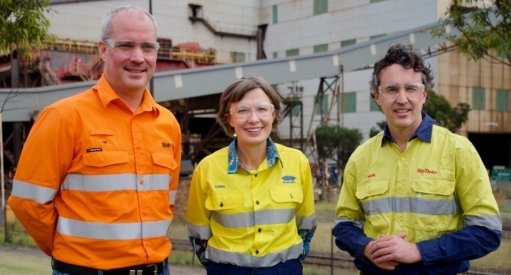PERTH, Australia–(BUSINESS WIRE)–In a collaborative effort to expedite the decarbonization of steelmaking, Australia’s top two iron ore producers and its largest steelmaker have joined forces to explore the potential development of the nation’s inaugural ironmaking Electric Smelting Furnace1 (ESF) pilot plant.
Through a newly established framework agreement, Rio Tinto (NYSE: RIO), BHP, and BlueScope will consolidate their progress thus far, capitalizing on the extensive expertise of both BHP and Rio Tinto in Pilbara iron ores, along with BlueScope’s unparalleled operational knowledge in ESF technology.
The partnership offers an opportunity to create and potentially invest in a pilot facility, intending to demonstrate the viability of producing molten iron from Pilbara ores using renewable power and Direct Reduced Iron (DRI) process technology. If successful, this collaboration could pave the way for steelmakers who rely on Australian iron ore to achieve near-zero greenhouse gas emissions in their operations, meeting the global steel demand.

To determine the best location for the pilot facility, the parties will evaluate various sites in Australia, taking into account factors such as supporting infrastructure, available workforce, access to target industries and supply chain partners, and suitability for operational trials. The pre-feasibility study work program is expected to be completed by the end of the year. If approved, the pilot facility could be operational as early as 2027.
Simon Trott, the Chief Executive of Rio Tinto Iron Ore, emphasized the urgent need for significant changes in the carbon intensity of iron and steelmaking to align with our planet’s sustainability and climate goals. He stressed the importance of exploring innovative technologies to ensure the production of these materials in a more sustainable manner.
We firmly believe that addressing such a monumental challenge requires collaboration with industry stakeholders. This newly formed agreement builds upon the extensive two-year collaboration we have already undertaken with BlueScope on this technology. By leveraging Rio Tinto’s and BHP’s unparalleled expertise in Pilbara ores, along with BlueScope’s technical steelmaking capabilities and unique operational knowledge, this partnership is poised for success.
We are thrilled to include this partnership
As part of our ongoing projects with our customers and suppliers. Together, we aim to discover better approaches that will expedite their efforts in achieving their decarbonisation targets.
Tim Day, the incoming BHP Western Australia Iron Ore (WAIO) Asset President, expressed his excitement about partnering with Rio Tinto and BlueScope to advance a potential breakthrough in reducing carbon emissions from steel production. Such collaborations are crucial for the success of these technologies and build upon their previous work on blast furnace abatement projects, as well as their ongoing research and development initiatives with renowned steelmakers, research institutes, and technology providers worldwide.
By combining their expertise, they aim to expedite the development of near-zero emission-intensity pathways for steelmakers utilizing Pilbara ores. These technology pathways should be compatible with renewable energy sources and capable of scaling up to produce hundreds of millions of tonnes of steel. Achieving this would be a significant milestone in establishing Pilbara ores, and the world at large, on a trajectory towards a future with reduced greenhouse gas emissions.

Tania Archibald, the Chief Executive of BlueScope in Australia, has expressed a clear vision for the company. She envisions BlueScope as a vibrant, modern, and sustainable manufacturer that plays a crucial role in Australia’s energy transition. One of the top priorities for BlueScope is to establish a pathway towards low emission-intensity iron and steelmaking in Australia. To achieve this, BlueScope is thrilled to collaborate with Rio Tinto and BHP to explore the decarbonisation of the ironmaking process. They aim to capitalize on Australia’s natural advantages, such as its iron ore resources and the abundant potential for renewable energy.
BlueScope firmly believes that Direct Reduced Iron (DRI) technology holds the most promise for decarbonising their Australian operations. The development of Energy Smart Furnace (ESF) technology is crucial in unlocking Australia’s unique advantages in this decarbonisation journey. Moreover, this technology has the potential for broader adoption across the global steel industry. BlueScope is confident that their collaboration, where they can contribute their unique experience in operating an ESF, will be instrumental in finding solutions for low emission-intensity ironmaking using Pilbara ores.
Australia Pilot Electric Smelting Facility
A pilot facility is being proposed to test and optimize the production of iron using the ESF, a furnace developed by leading steel producers and technology companies. The goal is to create low CO2 emission-intensity steel. The ESF is capable of producing iron that is suitable for the basic oxygen steelmaking process. Initially, iron ore is converted into direct reduced iron (DRI) before being charged into the ESF. By utilizing the DRI-ESF equipment, the need for metallurgical coal and blast furnaces can be eliminated. Estimates suggest that processing Pilbara iron ores through the DRI-ESF pathway could potentially achieve reductions of over 80% in CO2 emission intensity compared to the current industry average for conventional blast furnace steel production.
Other production methods with lower CO2 emission-intensity, such as electric arc furnaces, require scrap steel and DRI made from high-grade iron ores. The ESF offers greater flexibility in terms of input raw materials, which addresses one of the main obstacles to wider adoption of low carbon emissions technology. Additionally, the ESF has the potential to be integrated into existing downstream production units of a steel plant.
